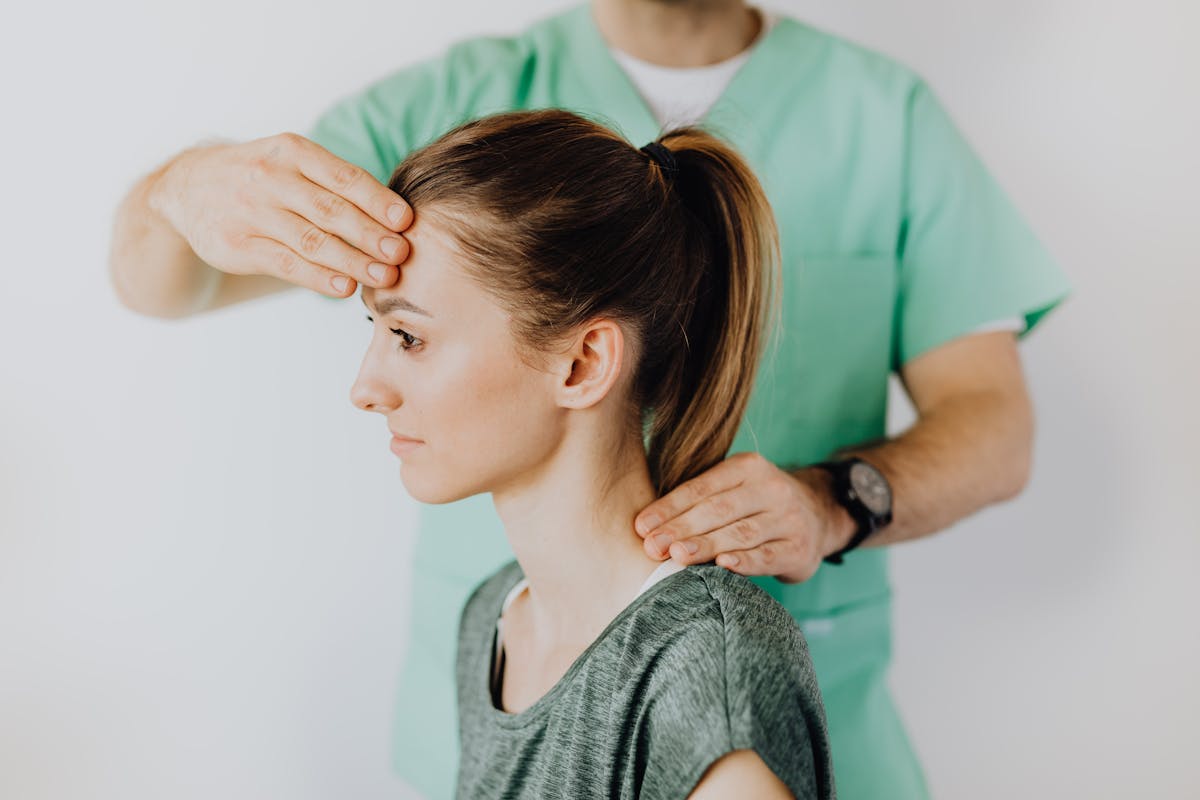Recovering from neck fusion surgery is a delicate process, and incorporating gentle exercises can greatly aid in restoring strength and mobility. After a month, patients may begin simple isometric exercises, shoulder shrugs, or even specific therapeutic yoga poses. However, it is essential to understand the nuances behind each exercise’s benefits and the safe way to perform them to avoid causing strain or harm. Let’s explore further into the world of post-surgery exercises, their safety measures, and how they contribute to a successful recovery journey.
Understanding Neck Fusion Surgery
To fully comprehend the importance of postoperative exercises, one must first understand what neck fusion surgery entails. This surgical procedure, also known as cervical fusion, is typically employed to address severe neck pain and instability caused by degenerative disc disease, herniated discs, or spinal instability. The surgery involves removing the damaged disc and inserting bone grafts or implants to facilitate the fusion of the adjacent vertebrae, thereby alleviating pain and restoring stability.
However, like any major surgery, neck fusion comes with inherent Fusion Surgery Risks. These may include infection, excessive bleeding, nerve injury, difficulty swallowing or speaking, and, in rare cases, paralysis. Additionally, the surgery may not fully alleviate the symptoms or could potentially lead to adjacent segment disease, where the vertebrae above and below the fusion site suffer additional stress and degenerate over time.
Given these potential risks, it is not uncommon for patients and healthcare professionals to explore Alternative Treatments before resorting to surgical intervention. Non-surgical options can include physical therapy, pain management techniques, chiropractic care, and lifestyle modifications, all of which aim to manage symptoms and improve quality of life without the need for invasive procedures.
Importance of Post-Surgery Exercise
Engaging in appropriate exercises after neck fusion surgery is vitally important for the best recovery. It not only facilitates the restoration of strength and mobility, but also greatly reduces the risk of complications. However, it is essential to adhere to safety precautions during these rehabilitation exercises to avoid potential injuries.
Benefits of Rehabilitation
Moreover, the role of postoperative exercises in promoting faster recovery and excellent functionality after neck fusion surgery cannot be overstated. Rehabilitation psychology underscores the importance of a holistic approach to recovery, which includes physical, emotional, and cognitive aspects. This approach aids in improving patients’ quality of life by promoting self-efficacy, resilience, and adaptive coping mechanisms during the postoperative period. Additionally, aquatic therapy is a beneficial tool in the rehabilitation process. The buoyancy, resistance, and cooling effect of water can help alleviate pain, enhance mobility, and improve strength and endurance. This form of therapy is often recommended due to its low-impact nature, making it a suitable choice for patients recovering from neck fusion surgery.
Exercise Safety Precautions
Adhering to safety precautions while engaging in post-surgery exercises is of paramount importance to guarantee a successful recovery process after neck fusion surgery. Safety measures guarantee you don’t strain or injure your neck, which could potentially delay your healing process.
Key safety precautions include:
- Proper Hydration: Stay well-hydrated before, during, and after the exercise. This helps to keep your muscles flexible and reduces the risk of cramps.
- Exercise Equipment: Use only prescribed or approved equipment. Misuse or use of inappropriate equipment could lead to injuries.
- Correct Posture: Maintain a good posture during the exercise. Incorrect posture can put undue stress on your neck.
- Physician’s Guidance: Always follow the instructions of your surgeon or physical therapist. They understand your specific condition and recovery needs.
Safety Precautions for Neck Exercises
Prioritizing one’s safety during neck exercises post-surgery is paramount to avoid exacerbating physical damage or causing new injuries. Pain management is critical; hence, patients should always listen to their bodies. If any exercise causes discomfort or pain, it should be stopped immediately. It’s imperative to communicate openly with your physical therapist about your pain levels to adjust your exercise plan accordingly.
Using equipment correctly is another pivotal aspect of safety. Any exercise equipment, such as resistance bands or weights, should be used under the guidance of a trained professional to prevent misuse and potential injury. Incorrect usage can lead to undue strain on the neck and spine, impeding the recovery process.
Furthermore, patients should avoid any high-impact or strenuous exercises that could put excessive pressure on the neck. Instead, focus on low-impact activities and exercises that promote flexibility and strength without straining the neck. Always remember, the goal is to aid recovery, not hinder it.
Lastly, maintaining proper form during exercises is crucial. Executing exercises incorrectly can lead to additional stress on the neck, potentially causing further damage. It’s recommended to always perform exercises under professional supervision, especially in the early stages post-surgery.
Gentle Neck Stretches and Their Benefits
Incorporating gentle neck stretches into your post-surgery recovery plan can offer a myriad of benefits, including increased flexibility, improved range of motion, and enhanced muscle strength. These exercises are critical for fusion surgery recovery as they aid in neck mobility improvements, which can be notably restricted after the surgery.
Gentle neck stretches help to:
- Increase flexibility: Stretching your neck muscles gradually can enhance their flexibility, which in turn improves overall neck mobility.
- Improve range of motion: Regular neck stretches help restore the neck’s normal range of motion that might have been affected by the fusion surgery.
- Enhance muscle strength: Gentle neck stretches can lead to a gradual increase in the strength of neck muscles, aiding in a more stable and supportive neck structure post-surgery.
- Promote faster recovery: Regular and controlled neck stretches can expedite the recovery process by promoting blood circulation to the neck muscles and tissues, increasing the flow of nutrients needed for healing.
Easy Isometric Exercises for Neck
Moving on from gentle neck stretches, it is equally important to contemplate easy isometric exercises as a significant part of your neck fusion surgery recovery process. Isometric exercises, which involve contraction of muscles without visible movement, can be a valuable addition to your rehabilitation program due to the numerous isometric training benefits.
Isometric exercises help improve muscular strength and stability by engaging the muscles in a static hold. This can be particularly beneficial after neck fusion surgery, as it can help reinforce the neck muscles without placing undue strain on the surgical site. Additionally, these exercises can enhance muscle endurance, promote better posture, and facilitate greater neck mobility over time.
One effective isometric exercise involves using neck resistance bands. To perform this exercise, securely fasten the band around a stationary object at head height. Stand with your back to the object, place the band around your forehead, and gently push your head forward against the resistance. Hold for a few seconds, then relax. Repeat several times, ensuring you maintain a comfortable level of resistance throughout.
Shoulder Shrugs and Circles
Alongside isometric exercises, shoulder shrugs and circles represent another important method of strengthening neck muscles post-surgery. These exercises are simple yet impactful, targeting the trapezius, deltoids, and other supporting muscles around the neck region. Depending on your comfort level and recovery progress, you can perform variations of these exercises at different speeds.
Shrug variations and circle speeds play a vital role in the effectiveness of these exercises. It’s essential to perform them correctly to avoid unnecessary strain or injury. Here are some tips:
- Start with slow, deliberate shoulder shrugs. Lift your shoulders towards your ears, hold for a few seconds, then release.
- Gradually increase the speed of your shrugs as your strength and comfort improve.
- For shoulder circles, start with small, slow circles then gradually increase the diameter and speed as your mobility improves.
- Alternate between clockwise and counter-clockwise circles to guarantee even muscle engagement.
Guided Therapeutic Yoga Poses
Shifting to the domain of therapeutic yoga, specific poses can be beneficial for enhancing strength and flexibility in the neck region post-fusion surgery. This form of gentle exercise is designed to promote healing, reducing inflammation, and improving circulation, all while providing mental relaxation.
Yoga equipment recommendations for neck fusion patients include a high-quality yoga mat for comfort and grip, a yoga block, and a strap to assist with poses and stretches. These tools can help users maintain alignment and provide support for postures, thereby minimizing the risk of injury.
A personalized yoga plan, designed by a certified yoga therapist, is essential to guarantee safety and effectiveness. This plan should take into account the patient’s overall health, level of discomfort, and specific post-surgery needs. A typical plan might include the ‘Mountain Pose’ for posture alignment, the ‘Cat-Cow Pose’ for gentle spinal movement, and the ‘Child’s Pose’ for relaxation and gentle stretching of the neck.
Helpful Breathing Exercises
Breathing exercises play a vital role in the recovery process after neck fusion surgery, contributing to enhanced lung function and overall relaxation. These exercises, including diaphragmatic breathing and pursed-lip breathing, promote more efficient oxygen intake and can also help manage pain. Additionally, incorporating progressive muscle relaxation techniques can further aid in reducing tension in the body, contributing to quicker recovery and improved well-being.
Diaphragmatic Breathing Basics
Mastering diaphragmatic breathing is a fundamental and beneficial exercise to strengthen the neck muscles after fusion surgery. This technique is not only instrumental for respiratory health improvement but also serves as an effective stress management technique.
- Positioning: Start by lying down or sitting comfortably, placing one hand on your chest and the other on your abdomen.
- Inhale: Breathe in slowly through the nose, allowing your diaphragm to move up into your ribcage, not your shoulders.
- Exhale: Breathe out slowly through your mouth, feeling your diaphragm move down.
- Repetition: Practice this for several minutes each day, gradually increasing duration.
This practice encourages deeper, more efficient breaths, reducing strain on neck muscles and promoting recovery. Remember, always consult your therapist before beginning any new exercise regimen.
Benefits of Pursed-lip Breathing
While diaphragmatic breathing is essential, incorporating pursed-lip breathing into your post-surgery regimen can be highly beneficial for neck muscle recovery and stress reduction. Pursed-lip breathing aids in controlling the breath, leading to longer, slower exhales that help in improving oxygen saturation. The stress reduction benefits of this practice cannot be overstated, as it aids in calming the nervous system and reducing anxiety, which are important for post-surgery recovery. Regular practice can also have significant cardiovascular impacts, such as lowering heart rate and blood pressure. Additionally, pursed-lip breathing promotes a more efficient exchange of oxygen and carbon dioxide, which is particularly essential after any surgical procedure. In the context of neck fusion surgery, it aids in alleviating tension and fostering the healing of the neck muscles.
Progressive Muscle Relaxation Techniques
Building upon the foundation of pursed-lip breathing, you can further optimize your recovery from neck fusion surgery by incorporating progressive muscle relaxation techniques into your routine. These techniques involve tensing and relaxing different muscle groups to promote relaxation and alleviate stress.
Here are some methods to incorporate:
- Relaxation audio guides: These guides can lead you through the process of tensing and relaxing each muscle group. They are an excellent resource for beginners.
- Massage therapy: A professional therapist can help relieve muscle tension and promote relaxation.
- Deep breathing: While tensing and relaxing your muscles, focus on your breath to enhance relaxation.
- Visualization: Visualizing each muscle group relaxing can further enhance your relaxation experience.
Through these techniques, you can promote healing and regain strength following your surgery.
Importance of Regular Walking
Embracing a routine of regular walking post neck fusion surgery plays a critical role in enhancing recovery, improving flexibility, and promoting overall well-being. The walking benefits are plentiful, often producing a positive ripple effect across various aspects of health.
With every step, walking stimulates the flow of oxygen and nutrients to the spine, which can aid in the healing process. As a low-impact exercise, it puts minimal strain on the neck and back, reducing the risk of injury while gradually building strength and endurance.
Cardiovascular improvement is another significant benefit of regular walking. By increasing heart rate, it promotes better blood circulation, which not only speeds up recovery but also improves heart health. Regular walking, even at a moderate pace, can help lower the risk of high blood pressure, diabetes, and high cholesterol.
Moreover, walking can be therapeutic, helping to alleviate post-surgical stress and anxiety. It enables patients to regain a sense of normalcy and control, which can be instrumental in maintaining positive mental health during the recovery period.
Maintaining Good Posture
Ensuring proper alignment of the body after neck fusion surgery is vital to expedite healing and reduce discomfort. The significance of maintaining good posture extends beyond immediate recovery, impacting long-term spinal health and overall physical well-being. The upcoming section will address the importance of posture and discuss effective strategies for post-surgery posture corrections.
Importance of Posture
The cornerstone of rehabilitation after neck fusion surgery is the consistent maintenance of good posture, an essential element that promotes healing and prevents further injury. Posture awareness and ergonomic considerations are fundamental principles in this process. Poor posture can strain the healing surgical site, potentially leading to complications and discomfort. On the other hand, maintaining correct alignment can greatly reduce the risk of recurring neck pain and further spinal problems.
Here are some benefits of good posture after neck fusion surgery:
* It promotes efficient healing by reducing strain on the surgical site.
* It helps prevent unnecessary tension and pressure on the neck and surrounding muscles.
* It aids in restoring mobility and flexibility.
* It reduces the risk of further injury and complications.
Post-Surgery Posture Corrections
Maintaining a correct and balanced posture after neck fusion surgery is essential to optimize the healing process and avoid undue strain on the neck and spine. Implementing posture training devices can be beneficial as they actively guide the body to align correctly, thereby reducing the risk of incorrect positioning. These devices can include wearable tech that provides real-time feedback to correct posture. In addition, investing in ergonomic furniture can offer significant benefits for post-surgery recovery. Ergonomically designed furniture, like chairs and desks, promote natural alignment of the spine, thereby reducing pressure on the fusion site. Combining these strategies can effectively improve posture, facilitating a more efficient healing process and reducing potential complications.
Monitoring Your Progress
Regular assessment of your rehabilitation progress post neck fusion surgery plays an essential role in ensuring a successful recovery. Progress tracking methods and recovery milestones can provide a helpful roadmap to gauge your healing trajectory. Each individual’s recovery journey is unique and may vary in time and intensity depending on the complexity of the surgery, age, and overall health condition.
To help you monitor your progress systematically, consider the following:
- Keeping a Recovery Journal: Jot down daily activities, levels of discomfort, and any new or unusual symptoms. This data can provide valuable insights into your progress and areas of concern.
- Regular Physiotherapy Assessments: Your physical therapist will evaluate your progress regularly and adjust your exercise regimen accordingly.
- Self-Assessment of Pain and Mobility: Track changes in pain levels and range of motion. Improvement in these areas often indicates successful healing.
- Scheduled Follow-ups with Your Surgeon: These visits allow your doctor to assess your surgical site, discuss your recovery journal, and make necessary adjustments to your recovery plan.
When to Contact Your Doctor
Understanding when to seek medical attention during your recovery period is important to prevent complications and promote ideal healing after neck fusion surgery. Continuous and effective doctor communication is a key element of post-operative care, aiming to make sure any concerns are addressed promptly, and possible hitches are quickly identified and managed.
Patients should be vigilant to any unusual symptoms or severe discomfort, and should not hesitate to contact their healthcare provider. Indicators of potential complications may include persistent or worsening pain, difficulty swallowing or breathing, fever, redness, swelling, or discharge at the surgical site. These symptoms could signify an infection or other serious issues that may require medication adjustments or further interventions.
Furthermore, discussing with your doctor any concerns regarding your medication regimen is important. Factors such as unexpected side effects, inadequate pain control, or the need for prolonged use of certain medications may necessitate a review of your current prescriptions.
Frequently Asked Questions
Can I Return to My Regular Gym Routine After Neck Fusion Surgery?
Resuming your regular gym routine post neck fusion surgery requires careful consideration. Prioritize exercises for posture improvement and stress management, but always consult your physician for personalized advice tailored to your recovery progress.
What Types of Swimming Exercises Are Safe After Neck Fusion Surgery?
Swimming exercises, particularly water aerobics, can be beneficial post-surgery due to the buoyancy and resistance water offers. However, safety is paramount; consult with your physician or physiotherapist for specific, personalized exercises appropriate after neck fusion surgery.
How Can I Ensure Comfortable Sleep Positions After Neck Fusion Surgery?
After neck fusion surgery, comfortable sleep positions can be guaranteed through proper pillow arrangements. Use a supportive neck pillow to maintain a neutral sleep posture, reducing strain and promoting healing post-surgery.
Are There Any Recommended Dietary Changes During Recovery From Neck Fusion Surgery?
Post-surgery nutrition is essential for healing. Incorporate protein-rich foods, fruits, vegetables, and whole grains. Additionally, post-surgery supplements like vitamin C, D, calcium, and zinc can aid in recovery after neck fusion surgery.
Can I Engage in Sports Activities One Month After Neck Fusion Surgery?
Engaging in sports activities one month post neck fusion surgery requires caution. Sporting precautions and a carefully planned post-surgery rehabilitation program are essential. Consult your surgeon or physical therapist for personalized advice on safe and beneficial activities.



